Africa
adventure Films
Campsites in Botswana
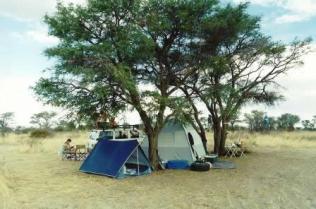
Camping in Botswana Parks and Reserves
Over 17% of Botswana has been set aside as national parks and game reserves. From the green of the Okavango Delta in the north to the red desert dunes in the south, great areas of wilderness have been carefully preserved to offer visitors an opportunity to experience Nature at its very best; to feel a sense of solitude; to see an incredible variety of wildlife species and to enjoy the prolific bird life.
Within the national parks and game reserves, areas have been set aside in which visitors may camp. Many of these areas have only the most basic of facilities or are completely undeveloped, whilst other areas have formal ablution blocks. The following information is therefore provided to assist visitors to select the areas and facilities that suit them best and to give details of what is available in each area.
As a general rule each individual campsite may accommodate a maximum of six persons and two vehicles. Where exceptions to this occur they will be specified in the following text.
Although the national road networks between main centers are tarred and in first class condition, many of the access tracks that lead to the parks and reserves, and many of the tracks within the protected areas, are rough and sandy, requiring the use of a 4x4 vehicle.
Access to the parks and reserves has been limited in order to ensure that visitors have an enjoyable experience and can feel the wilderness atmosphere. Because of this, advance bookings for campsites are essential.
Parks and Reserves Reservations Offices
Reservations, up to twelve months in advance, must be made through either of the two reservations offices as follows:
- Parks and Reserves Reservations Office
P O Box 20364, Boseja, Maun, Botswana
Telephone No: (267) 6861265, Fax No.: (267) 6861264
Physical location: Next to the Police Station in Maun. - OR Parks and Reserves Reservations Office
P O Box 131, Gaborone, Botswana
Telephone No: (267) 3180774, Fax No: (267) 3180775, E-mail: DWNP@gov.bw
Physical location: Kgale Millennium Park opposite Game City Mall heading South, we are in the compound with Auditor General and CID.

Central Kalahari Game Reserve (CKGR)
Within the northern section of the Central Kalahari Game Reserve there are designated but undeveloped campsites at -
- Deception - 6 campsites
- Kori - 4 campsites
- Lekhubu - 1 campsite
- Letiahau - 1 campsite
- Sunday Pan - 3 campsites
- Lengau - 1 campsite
- Passarge Valley - 3 campsites
- Western Link - 2 campsites
- Piper Pan - 2 campsite
- Xade - 2 campsites
Water is currently only available at the Game Scout Camp at Xade. Visitors must carry in their own drinking water. Petrol and diesel are not available within the reserve - the nearest being at Rakops (usually reliable) on the east of the reserve, or in Ghanzi to the west.? It is advisable for visitors to carry additional fuel for their stay within the reserve. Basic foodstuffs are available in Ghanzi and Rakops.
Trans-Kalahari travel between Khutse Game Reserve in the south and the northern section of CKGR can be undertaken by a minimum of two 4x4 vehicles - this arduous trip takes two days.
Planned for the future: Rustic bush latrines for most campsites. New entrances will be built into the NW and SW corners of CKGR.

Chobe National Park
- Ihaha
At Ihaha, overlooking the Chobe River, there is a public camping ground consisting of ten individual campsites. There are modern facilities available (An ablution block with showers, hand basins, flush toilets and water standpipes within the camping ground).
Fuel and food supplies are available in Kasane.
Note: Serondela is closed to campers. - Savute
New modern facilities are available at the Savute public camping ground. This includes an ablution block with showers, hand basins, flush toilets and water standpipes.
The nearest fuel and food supplies are in Maun or Kasane. Visitors should therefore ensure that they are self sufficient for their full journey between these points. - Linyanti
There is a small public camping ground at Linyanti, which has three individual campsites only. There are water standpipes, showers and flush toilets. Food and fuel supplies are available in Kasane and visitors should carry with them sufficient for their whole journey through the park.
NOTE: ALL PAYMENTS AT PARK LEVEL MUST BE MADE IN PULA CASH PLEASE
KGALAGADI TRANSFRONTIER PARK - Botswana side, formerly Gemsbok National Park
The Kgalagadi Transfrontier Park was launched in May 2000 and now tourists may travel throughout the park, which comprises of the former Kalahari Gemsbok National Park (RSA) and Gemsbok National Park (Botswana). Note that only Pula can be accepted on the Botswana side of the park. Immigration facilities are now being provided at Two Rivers so that tourists may enter from one country and leave the park into the other country.
- Two Rivers Area
This camping ground, near the entrance gate, offers ablution blocks and three shade structures. It is the only camping ground on the Botswana side, which is fenced. - Rooiputs Camping Ground
The Rooiputs camping ground is situated some 25 km up the Nossob river Valley from Two Rivers entrance gate. It offers six individual campsites, each of which has its own shade structure, fireplace, rustic pit latrine and shower shelters. The water supply is unreliable so bring your own water. - Polentswa
This camping ground lies in the northern section of the Nossob River Valley and has three campsites with shade structures, pit latrines and shower shelters (you provide the water). - Gemsbok Wilderness Trail
A 3-day/2-night wilderness trail through the unspoiled interior of the Gemsbok NP is open to visitors on a pre-booking basis only. Full details are available at the reservations offices. Visitors are advised that petrol, diesel and food supplies are obtainable at Twee Rivieren on the South African side of the border. Payments may be made in Rand or Botswana Pula. Water for purposes other than drinking can be obtained from the Two Rivers Game Scout Camp. Food supplies and fuel may be obtained in Tshabong.
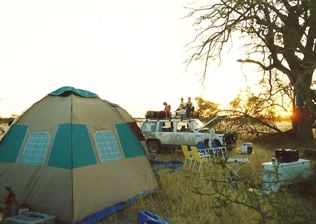
THE MABUASEHUBE AREA
- Mabuasehube Entrance
There is a new campsite with ablutions just inside the Mabuasehube entrance to the park. At the following pans in the interior of the park there are other campsites with a variety of facilities. - Monamodi, Lesholoago and Mpaathutlwa
At each of these there are two shade structures, with pit latrines and showers with water. - Mabuasehube pan
Four shade structures, with pit latrines and showers with water. - Khiding pan and Bosobogolo pan
At both of these pans there are campsites with two shade structures, with pit latrines and shower shelters where the camper provides the water.
For those people who prefer their wilderness without any facilities, there are some other campsites in Mabuasehube at all the above named pans that have not been developed.
Planned for the near future
- New Trail: It is planned to open up new routes (in 2001) linking the Nossob Valley with the Mabuasehube end of the park.
- New Entrance: A new entrance has been completed at Kaa, on the northern boundary of the Park. It will enable tourists to drive through the park and leave into beautiful wilderness areas to the north of the park and later join the Trans Kalahari Highway at Kang once the appropriate tracks have been developed.
Khutse Game Reserve
Within Khutse Game Reserve, there are a variety of individually sited campsites.
- Khutse Campground: Situated between Khutse I and Khutse II Pans. Ten individual campsites with centrally placed pit latrines.
- Mahurushele Pan: Two campsites near the edge of the pan. No facilities. *
- Sekushuwe Pan: One campsite under a large camel thorn acacia. No facilities. *
- Khankhe Pan: Four campsites on the dune overlooking the pan. No facilities. *
- Molose Waterhole: Four campsites with no facilities.
- Moreswe Pan: Four campsites with pit latrines. Small saline waterhole. (Campsites located in southern CKGR but administered by Khutse.)
The nearest reliable fuel and food supplies are at Molepolole, so visitors should ensure that they have sufficient supplies for the duration of their stay.
Water for purposes other than drinking can be obtained from the Game Scout Camp.
Planned for the future: A new entrance will be built with a campsite and an ablution block nearby. Rustic bush latrines and showers to be built at most of the other camping areas.

Makgadikgadi Pans National Park
Makgadikgadi Pans National Park has within it both formal and informal camping facilities. This park borders onto the Nxai Pan National Park and it is recommended that a visit should be planned to take in both areas.
- Kumaga Campground: 5 campsites with an ablution block containing showers, hand basins and flush toilets and there is a centrally placed water standpipe. This camping ground overlooks the currently dry Boteti River and is close to the Game Scout Camp.
- Njuca Hills: 2 campsites with rustic bush latrines only on a slightly elevated area. Each of these campsites may accommodate a maximum of twelve persons and three vehicles.
The nearest fuel and food supplies are at Gweta, although very limited food supplies can be obtained in the Kumaga village.
Water is available at the main entrance or at Kumaga. However the water at Kumaga has a very sulfurous smell.
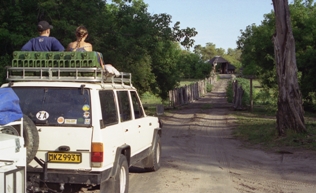
Moremi Game Reserve
The Moremi Game Reserve adjoins the southernmost boundary of the Chobe National Park and many visitors include both these protected areas in their itinerary. Moremi is part of the Okavango Delta and has four public camping grounds as follows:
- Maqwee
There are seven campsites near the entrance at South Gate. There are ablution blocks which have showers, hand basins and flush toilets. Two water standpipes and picnic tables are conveniently placed within the camping ground. - Khwai
Ablution blocks with showers, hand basins and flush toilets service the seven campsites at Khwai, situated near the North Gate and just across the river from Khwai village. Water standpipes and picnic tables are also provided. - Xakanaxa
Seven campsites are situated along the edge of the Okavango Delta, serviced by an ablution block with showers, hand basins and flush toilets. Limited picnic tables and water standpipes are also available. - Third Bridge
This public camping ground once again has seven campsites and is serviced by an ablution block with showers, hand basins and flush toilets. There is a water standpipe.
The nearest fuel and food supplies are available in Maun, although very limited basic foods and cold drinks can be obtained in the Khwai village.
There is a viewing platform overlooking a large hippo pool on the route between Khwai and Xakanaxa, which is well worth a visit.
Planned for the future: New entrance gates will be built and all campsites upgraded.
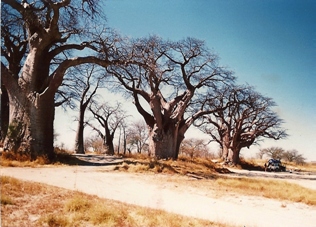
Nxai Pan National Park
Sharing a common boundary with Makgadikgadi, the Nxai Pan National Park has three areas in which visitors may camp.
- South Camp
Situated within a well-treed area not far from the entrance gate, the South Camp has four campsites with an ablution block containing showers and flush toilets. There are fire pits for each campsite and there are two water standpipes. - North Camp
There are three campsites at North Camp, with a standard ablution block, showers, hand basins and flush toilets. A water standpipe is central within the camping ground. It is currently closed because of elephant damage. - Baines Baobabs
The area around Baines Baobabs has three informal and totally undeveloped campsites. Each of these campsites can accommodate a maximum of twelve persons and three vehicles. Water can be obtained at the entrance gate where visitors are required to check in before proceeding to Baines Baobabs.
Two viewing platforms have been established in Nxai Pan, one adjoining the South Camp and the other up on the sand ridge where a panoramic view of the area can be obtained.
The nearest available fuel and foodstuffs are in Gweta. Campers should note that firewood is not available in Nxai Pan.
Planned for the future: A new entrance gate and refurbishing of? the campsites.
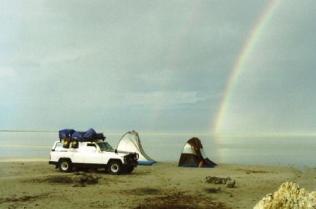
Educational Game Reserves
There are three educational game reserves namely Gaborone Game Reserve, Manyelanong Game Reserve and Maun Game Reserve. These reserves offer a variety of facilities and activities which include nature trails, observation hides, visitor centers, picnic sites, game viewing, bird watching, guided walks, environmental education programs etc.
General Notes for Travelling and Camping in Parks and Reserves
A 4x4 vehicle is essential and travelling with a second vehicle where possible is advisable. Always carry a container of water, extra fuel and basic spares when travelling within the parks and reserves.
Always stay on the established tracks in order to avoid the ugly scars left by off-road driving. Stay below the 40 kph speed limit for the safety of wildlife and yourselves, and to keep down dust.
Camp only in designated campsites and ensure that you leave behind no sign of your stay. Sleeping outside without a protective shelter is extremely dangerous. Always fasten your tent flaps at night to avoid unwelcome visits by scorpions and snakes. When camping in areas where monkeys, baboons and hyena are present, remember to secure your foodstuffs in your vehicle. Baboons and monkeys have become very brazen and will snatch foodstuffs from a camp table or out of vehicles if the camper's attention is diverted.
Please conserve firewood by using your own gas cooker and only have a fire at night for social purposes.
Please help to keep these wild areas clean and litter free, so that everyone can enjoy their pristine beauty.
Opening and Closing Hours
KGALAGADI TRANSFRONTIER PARK
January and February: 0600-1930 |
March: 0630-1900 |
April: 0700-1830 |
May: 0700-1800 |
June and July: 0730-1800 |
August: 0730-1830 |
September: 0630-1830 |
October: 0600-1900 |
November and December:530-1930 |
ALL OTHER PARKS AND RESERVE
1stApril-30th September |
1st October-31st March |
|
Open |
06:00 |
05:00 |
Close |
18:30 |
19:00 |
1stApril-30th September |
1st October-31st March |
|
Open |
06:00 |
05:00 |
Close |
18:30 |
19:00 |
1stApril-30th September |
1st October-31st March |
|
Open |
06:00 |
05:00 |
Close |
18:30 |
19:00 |
FEES FOR PARKS AND RESERVES
KGALAGADI TRANSFRONTIER PARK ONLY
These Entry Fees apply to Day and Overnight visitors and to Citizens, Residents and Non-Residents.
CATEGORY |
PULA RATE |
RAND RATE |
Adults over 15 yrs old)per person per day |
20.00 per day |
25.00 per day |
Children (2 yrs to 15yrs old) per person per day |
10.00 per day |
12.00 per day |
Children (under 2yrs old) per person per day |
FREE |
FREE |
Vehicles- per car per day |
4.00 |
5.0 |
CAMPING FEES & ALL OTHER PARKS AND RESERVES
Department of Wildlife and National Parks
P O Box 131, Gaborone, Botswana
Click here to download Camping Fees and all other Parks and Reserves.